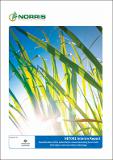| Abstract | NorrisECT conducted a series of SRDC supported trials into the potential to improve industry profitability through the use of post-harvest cleaning at sites in the New South Wales Sugar Milling Cooperative and Isis Mill cane catchments during the 2012 crushing season. The aim of the trials was to determine the potential to improve profitability by circumventing the existing compromise between high fibre levels in milled cane, and high cane loss during harvesting under commercial harvesting conditions. This was achieved through utilising ‘low loss’ harvesting to reduce the cane lost through the harvester cleaning system then a mobile cane cleaning plant to clean the cane before transport to the mill. The impact on tonnes of cane and CCS recovered per hectare, and the transport bulk density were measured. The trials investigated the impact on recovered cane yields and CCS across three treatments, including ‘commercial’ harvesting practices (moderate to high extractor fan speed), ‘low loss’ harvesting practices (low extractor fan speeds, reduced ground speed), and ‘low loss’ harvesting with post-harvest cleaning (using a NorrisECT mobile cane cleaning plant). Total biomass yield (tonnes per hectare), cane yield (tonnes per hectare), load density (kg per m3) were measured in the field, and the respective mills provided corresponding information on Pol, Brix, Ash, Fibre and CCS measurement (NIR). Trial results showed significant increase in biomass and delivered CCS yields per hectare resulting from ‘low loss’ harvesting practices, and a further increase in delivered CCS per hectare (through significant reduction in EM and fibre levels) attributable to post-harvest cleaning. Post-harvest cleaning treatments also demonstrated significantly higher transport load densities. The actual impact on harvesting costs were estimated based on the change in harvester productivity (hectares per hour) and haul out requirement (m3 of biomass per hectare) and benchmarked against a large harvesting dataset. Actual sugar recovery was estimated based upon both CCS determinations and earlier Australian and American work on the effect of extraneous matter and fibre on sugar recovery. The trials have demonstrated that there is potential to significantly increase the industry profitability with post-harvest cane cleaning based on the significant increase in potential sugar production per hectare of land, significant improvement in transport load density and significant reduction in fibre levels in cane milled. It is recommended that further work be undertaken to better quantify the actual impact NET001 Interim Report iii on harvesting and transport costs under commercial conditions, and to better quantify the impact on mill performance and costs, and sugar recovery through reduced fibre and extraneous matter levels. |

